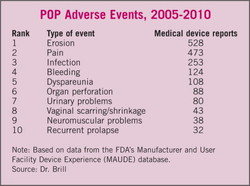Correction: Vaginal mesh is not the number one surgical treatment for pelvic organ prolapse. “
 Regarding the following answer by Dr. Kevin Windom:
Regarding the following answer by Dr. Kevin Windom:
“In my opinion vaginal mesh is the number one surgical treatment for pelvic organ prolapse (POP). Pelvic organ prolapse (POP) is when there is a tear in the connective tissue causing the bladder or bowel or intestines to protrude into the vagina. This, by definition, is a hernia in which these organs are prolapsing through a tear in the connective tissue. The best way to treat a hernia is by repairing the connective tissue. It is a very common practice for gynecologists throughout the United States to perform an anterior and/or posterior repair to remedy cystocele or rectocele respectively. This is a procedure where the connective tissue is “bustled up” to help with scaring and the hope is that this will keep the bladder or bowel from protruding into the vagina. This is a poor procedure because the patient has inherently weak connective tissue and, in my opinion, using the patient’s own connective tissue to remedy their problem is wrought with failure. These surgeries carry a 35%-45% failure rate. I believe that either biologic or polypropylene mesh is the best treatment for remedying pelvic organ prolapse (POP).”
My response to Dr. Kevin Windom:
Likely there are carefully selected patient who have severely weak fascia that there is no other viable choice but to use the mesh. A vast majority of patients can be managed with non-mesh related procedures with similar rates of successful outcomes. The next question is who is putting in the mesh. Mesh procedures should be carried out by trained urogynecologist with mesh tailored for the particular procedure as opposed to utilizing a mesh kit. Finally patient must be adequately be informed of the risk versus benefits prior to surgery.
Vaginal Mesh Resource of Dr. Greg Vigna, MD, JD
Social Media Tags: urogynecologist, connective tissue, vagina, kevin windom, polypropylene mesh, md jd






